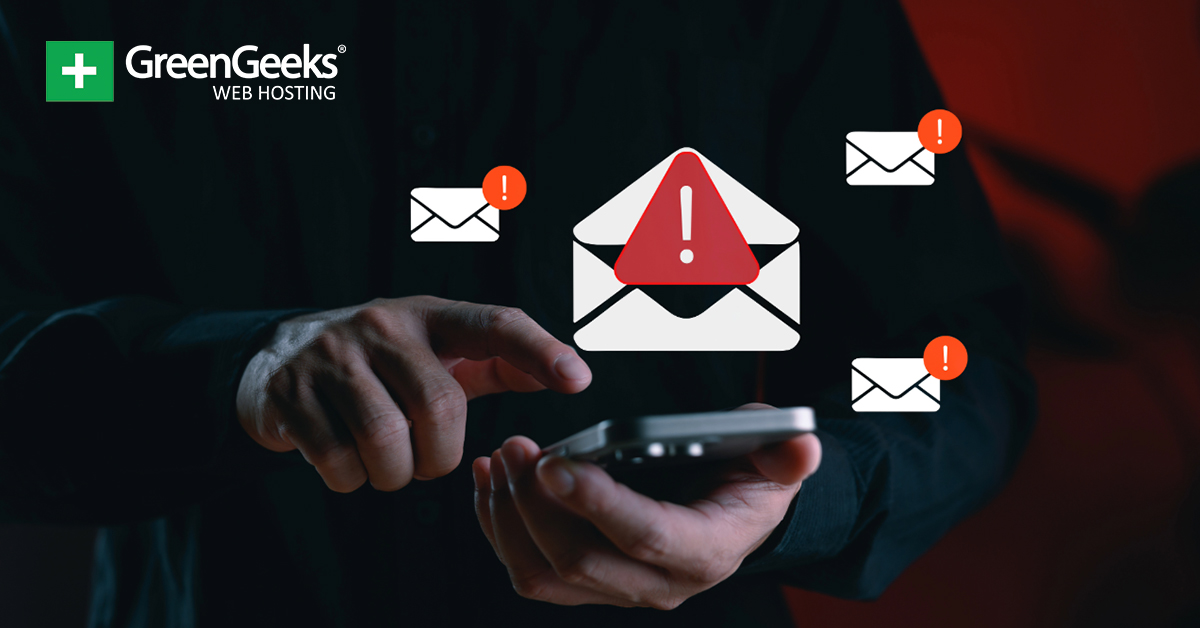
How to Identify and Report Suspicious Emails Claiming to Be from GreenGeeks
At GreenGeeks, we take security seriously. Recently, we’ve observed an increase in phishing emails targeting email addresses hosted on our servers. These messages may impersonate GreenGeeks or appear to come from trusted sources. To help protect your account and prevent further attacks, please review the following guidelines carefully.
If you’ve received a suspicious email, don’t panic. This is not unique to GreenGeeks.
Phishing is a widespread tactic used against customers of all major hosting providers, banks, software platforms, and even government institutions. Cybercriminals often send these emails in bulk or scrape websites for common email addresses — no provider is immune, but how we respond makes the difference.
Your awareness and caution are critical. This article will walk you through:
- How to recognize suspicious emails
- What steps to take (and avoid)
- How to report the message safely
- How to reduce your exposure to these threats in the future.
How to Recognize a Suspicious Email
Remember: Official emails sent from GreenGeeks regarding your billing details, unpaid invoices, or any security alerts will ONLY be sent to your primary email address on file for your GreenGeeks Account.
Legitimate emails from GreenGeeks will ALWAYS come from greengeeks.com, and we will never ask you to confirm your password via email.
Phishing emails are designed to trick recipients into clicking on harmful links, opening infected attachments, or revealing personal or account information. These messages may falsely appear to come from GreenGeeks or other trusted providers, often with the intent to steal sensitive information or infect your PC or device with malware.
These targeted types of phishing emails often try to:
- Urgently request that you log in to your account or verify personal details.
- Include links to websites that imitate official login pages.
- Attach files or links that contain malware or redirect to harmful sites.
Common signs of a phishing or malicious email:
- The sender email address doesn’t match official GreenGeeks communication domains.
- The message creates a false sense of urgency (e.g., “Immediate Action Required” or “Account Suspension Notice”).
- You’re asked to click on a link to verify your account, update billing information, or download an important document.
- The link’s destination does not match its label. (Hover your mouse over links to see the actual URL.)
- There are spelling or grammatical errors that seem unusual for professional communication.
- The email includes attachments from unexpected or unknown senders.
- GreenGeeks has been spelled differently, such as Green-geeks or greengeeks.
If an email looks suspicious:
- Do not click on any links or download attachments. These may contain malware or redirect you to a malicious website.
- Do not reply to the email. Replying confirms your address is valid, which can lead to more spam or phishing attempts.
- Do not forward the email to GreenGeeks. Forwarding suspicious messages may trigger spam filters in our ticketing system and could result in your IP address being blacklisted.
Report a Suspicious Email
If you believe an email is suspicious or fraudulent, follow these steps to safely report it:
- Capture the full email headers and raw source of the message. This information helps our team trace the origin of the message and take appropriate action.
- Take a screenshot of how the email appears in your email client or webmail interface.
- Open a new support ticket via your GreenGeeks Account, and provide both:
- The full email source headers and body in plain text format, and
- A screenshot of the suspicious message using a link-sharing service.
This method ensures your report reaches us safely without triggering any spam filters or risking blacklisting.
Tips to Prevent Targeted Email Attacks
Bots regularly scan websites looking for email addresses in plain text. Avoid using common email addresses like [email protected], [email protected], or [email protected]. These are frequently targeted by phishing campaigns.
Don’t list email addresses on your website; use contact forms instead! If you must list an email address on your website, you can attempt to obfuscate the address with JavaScript or an image.
The best way to prevent your email addresses from being harvested for phishing campaigns is to use a contact form instead of listing them publicly on your website. Also, make sure it’s protected by a CAPTCHA (like Google’s reCAPTCHA) to stop automated spam submissions.
Frequently Asked Questions for Suspicious Email
Attackers commonly harvest emails using bots to scrape websites or public records. Another common tactic is to address messages blindly to commonly used mailboxes (info@, admin@, sales@, etc).
No. In the vast majority of cases, these emails do not originate from GreenGeeks or our servers. They are sent externally and simply spoof the “From” field to appear as though they’re from us.
We have strong protections in place — including SPF, DKIM, and DMARC — to reduce email spoofing and spam abuse. Unfortunately, phishing emails can still reach inboxes if they come from outside our network and appear legitimate at first glance.
If you clicked a suspicious link, entered credentials, or opened a strange attachment, yes, we recommend changing your email password immediately and enabling two-factor authentication on your GreenGeeks Account.
We also recommend ensuring all website software is routinely updated. If your email or domain is connected to a CMS like WordPress, outdated software can be exploited and used to send spam from your site, including phishing emails such as this.
Conclusion
While GreenGeeks works around the clock to monitor deliberate abuse of our services, protect our systems, and respond to incidents, the first line of defense is awareness. By staying alert and following these best practices, you help keep your inbox secure and prevent phishing attempts from affecting your domain.
If you have any doubts about an email you received, reach out to our team through your GreenGeeks Account. We’d rather review a harmless message than see you fall victim to a scam.







